Everything you need to know about indentured servitude
3-4 minute read
By Jen Baldwin | September 27, 2020

Many English, Irish and German immigrants arrived in North America as indentured servants. Was your ancestor among them?
If you’ve ever wondered how your ancestors managed to scrape together enough funds to make a journey to a new continent, the answer may be in indentured servitude.
In its simplest form, indentured servitude works like this: An employee, (the indenturee), signs an agreement (the indenture) to work without pay for the owner of the indenture for a period of time. Common reasons for agreeing to these terms would have been for transportation to a new location or to pay off debts. On completion of the contract, the indentured servant was given their freedom.
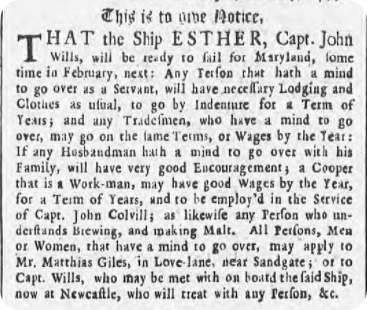
An ad for indentured servants, and more, published in the Newcastle Courant, 12 January 1739. Read the full page.
The number of unique circumstances, special situations and exceptions to the rule are substantial. Indentures were often sold and re-sold, at times extending upon the original period, typically seven years, and capturing the individual in a long chain of ongoing labour. The life of an indentured servant was usually difficult and unpleasant.
Indentured servitude occurred in North America, the Caribbean, Africa, India, Australia and elsewhere and was particularly popular in the 17th and 18th centuries. Upon arrival, the indenture was often purchased from the ship captain by a resident.
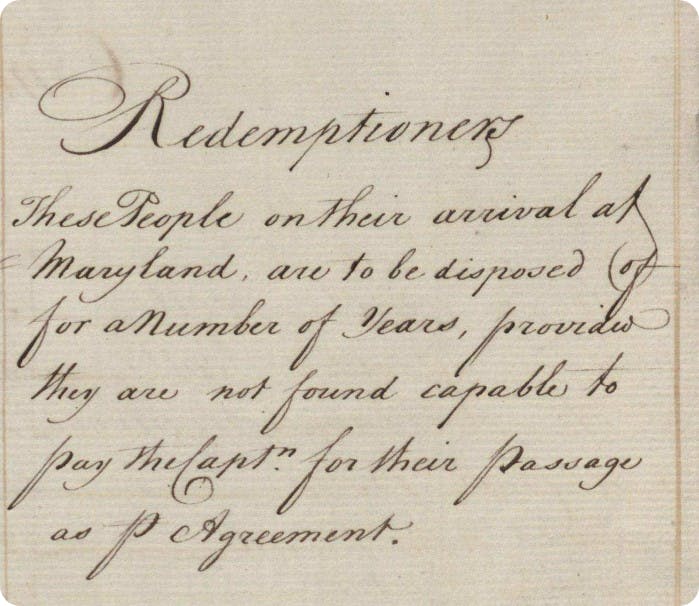
Above is a note on the status of passengers who left Britain for Baltimore onboard the Nancy on 12 June 1775. They included 15-year-old Robert Abbert. You can see the full list of passengers in Early Emigration from Britain, 1636-1815 on Findmypast.
This was the prominent labour system in place in British America until it was overcome by slavery. While many came from England, Ireland and Germany, individuals from all over the world were affected. In many countries today, the system has been outlawed and has been banned by the Universal Declaration of Human Rights.
The work undertaken varied by location but it was common to see indentures work in the fields, as domestic servants and a smaller number were obtained by craftsmen.
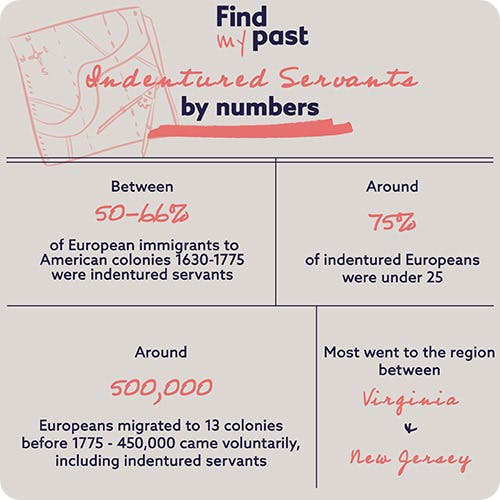
The advertisement for a runaway servant seen below includes details that could be useful for family historians.
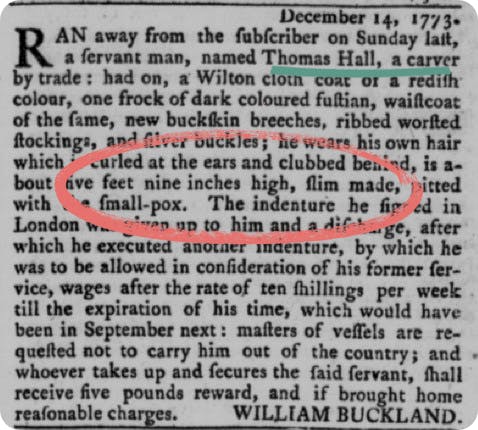
Annapolis Maryland Gazette, 6 January 1774.
Are indentured servants and slaves different?
You may have heard that indentured servants were essentially slaves. While there are some similarities, there are important distinctions that we should all be clear on. Let's be direct: indentured servants were not slaves.
The life of the average indentured servant was not easy and not all of them entered this situation willingly. Some were political prisoners. Some were children. However, the legal differences between indentured servitude and slavery are very apparent.
- Servants were considered legally human. Slaves were not
- Servitude was based on a contract that would eventually come to an end. Slavery was for forever
- Servitude status did not pass on to your children. They were born free. Slaves' children were enslaved upon birth and for life
- In Colonial America and the Caribbean, slavery had a specific legal meaning. Europeans, by definition, were not included in it
- Slavery is not a contract
The issue is heavily researched by historians and academics around the world. It has resulted in 82 scholars signing an open letter denouncing the Irish slave myth, specifically.
Records of indentured servants
There are a handful of good sources for indentured servitude available to genealogists today. The process often included the indenture itself, as well as a newspaper advertisement upon arrival. Then, the sale of the indenture to the buyer was typically recorded at the city court or with the town leadership.
- Price Genealogy offers their Immigrant Servants Database for free. It includes over 20,000 indentured servants who immigrated to America between 1607 and 1820
- Virtual Jamestown has a searchable database, the Registers of Servants Sent to Foreign Plantations, 1654-1686. It covers about 15,000 people who travelled from Bristol, Middlesex, and London, England to the mid-Atlantic colonies and the West Indies.
- Dr Carson Gibb and the Maryland State Archive offer The New Early Settlers of Maryland database, compiled from two texts. Maryland is unique as the colony incorporated a “process of headrights”, where a person could be granted 50 acres of land for every additional person that he transported there
- All available early passenger lists should be perused, such as the Early Emigration from Britain, 1636-1815 collection on Findmypast
- The British Indentured Servitude Project on WikiTree is a valuable online location for sharing research.
Most of these records are indexes only. Few paper records remain. Remember, these are often personal transactions between an individual and a ship captain or private landowner, so finding the actual indenture agreement is rare.
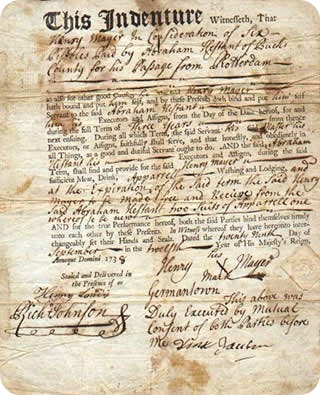
An indenture signed by Henry Mayer with an "X" in 1738. This contract bound Mayer to Abraham Hestant of Bucks County, Pennsylvania, who had paid for Mayer to travel from Europe.
It’s also a good idea to check other occupational records from the period, such as Findmypast's apprenticeship records, and look for vital events in the Armed Forces and Overseas Birth & Baptisms collection. Newspapers can also be an excellent source of information. The number of titles from the period in question is steadily increasing in Findmypast's newspaper collection.
The efforts of Price Genealogy, and a global community of researchers, have resulted in an excellent compiled list of additional information.
Certain aspects of history are uncomfortable to highlight. Nonetheless, at Findmypast, we are committed to shining a spotlight on them so that we can all learn from our shared heritage.
Related articles recommended for you

More footballers in the family? Jack Grealish’s family tree
Discoveries

Taylor Swift’s family tree shines with love, heartbreak and the triumph of the human spirit
Discoveries

This Remembrance weekend, discover the wartime stories of your ancestors
What's New?

